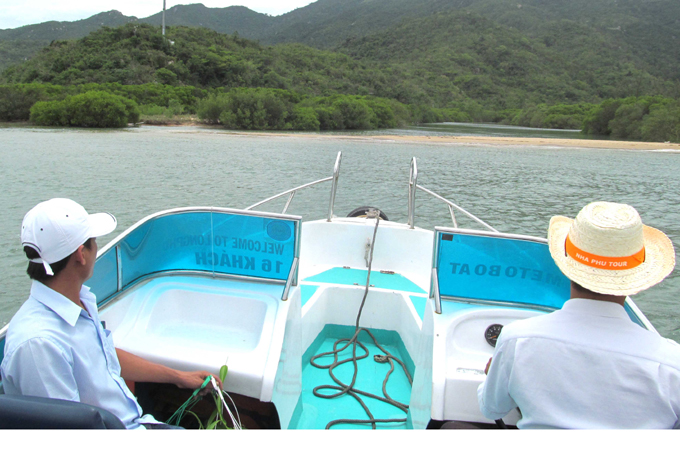
Mangrove forests in Khanh Hoa Province are at risk of extinction. Managers and scientists are urgently seeking for preservation methods...
Mangrove forests in Khanh Hoa Province are at risk of extinction. Managers and scientists are urgently seeking for preservation methods.
At risk of extinction
Khanh Hoa Department of Agriculture & Rural Development’s survey on mangrove forests 2017 reports only more than 60ha of mangroves while the figure before 1975 was 2,500ha. That means mangrove forests have been badly destroyed.

|
According to managers and scientists, mangrove forests are lost mostly in the period 1990 - 2000 due to the sharp increase in industrial shrimp farming. Thousands of hectares disappeared, especially in areas with high resources such as Nha Phu Swamp, Thuy Trieu Swamp, Tuan Le Forest, Vinh Thai-Phuoc Dong, Nha Trang City, etc. The mangrove forest degradation has effected the biodiversity. Suffering from loss from shrimp farming due to shrimp diseases, locals have become more aware of the importance of mangrove forests and the need to protect them. However, the number of mangroves restored seem to be negligible compared to the declines.
Besides, mangrove destruction for shrimp farming and socio-economic development projects are also blamed for the widespread mangrove degradation. For example, the construction of Co Ma- Dam Mon Road has badly damaged the 100-year-old Tuan Le Crabapple mangrove forest in Van Tho Commune, Van Ninh District.
“Preventing saline water from entering forests when the road was built has caused bad impacts on mangroves due to habitat change. Sonneratia is a typical plant of mangroves. It cannot survive without saline water", explains Engineer Tran Gioi, Khanh Hoa Nature & Environment Protection Branch.
Recently, some organizations and individuals have become aware of environmental issues as well as the role of mangrove forests and have joint effort to restore mangroves. In 2013, Cam Ranh Sugar Plant cooperated with Nha Trang Institute of Oceanography to plant mangroves in the area adjacent to Thuy Trieu Swamp in an attempt to create an ecological landscape as well help water filtration and trap excess sediment that is harmful to the environment. However, plastic waste has caused bad effect on the revival and development of the forest.
Seeking for preservation methods
According to scientists, mangrove forests on Hon Heo Peninsula are diverse and abundant with 54 species. The mangrove forest is diversified not only in species but also in use, e.g., as timber, medicinal plants, essential oils, food, ornamental plants, etc. The total area of Hon Heo mangrove forest is covering only about 30ha. Many species are in urgent breeding need for conservation with priority given to Barringtonia asiatica, Heliotropium foertherianum, Cordia subcordata, Limnocitrus littoralis, Bruguiera gymnorrhiza, etc.
Le Dinh Que, a forester in Ninh Phu, Ninh Hoa Forest Protection Unit says foresters’ challenges are due to the lack of fund and facilities, including means of water transportation for frequent forest protection patrols.
The joint effort in forest protection is needed and requires the support of businesses, especially eco-tourism ones.
Nguyen Van Huong, Head of the Department of Organization, Director of the Center for Research & Development, Long Phu Tourism Company says, since its privatization, the company has set a strategy for eco-tourism development on the 2 islands named Orchid and Monkey islands managed by the company. The Orchid Island has a mangrove forest which is well protected for development. The forest, presently 4.3ha, is expected to expand to 10ha. The mobilization of businesses’ joint effort in mangrove forest development has proved effective and thus incentives are required for further development and promotion.
PhD Luu Hong Truong, Director of Southern Institute of Ecology, Khanh Hoa confirms the value of mangrove forests on socio-economic development and environment. The survey on Hon Heo mangrove forests shows the interest and orientation for the conservation of precious genetic resources of mangrove forests. Therefore, a comprehensive study on mangrove forests throughout the province is needed for a master protection plan. Protection and conservation should go hand in hand with propaganda, management and penalties for environmental violation. Besides, it is essential to build a mangrove nursery garden, especially for rare and threatened species to restore mangroves effectively and sustainably.
V.Lac
Translated by N.T









